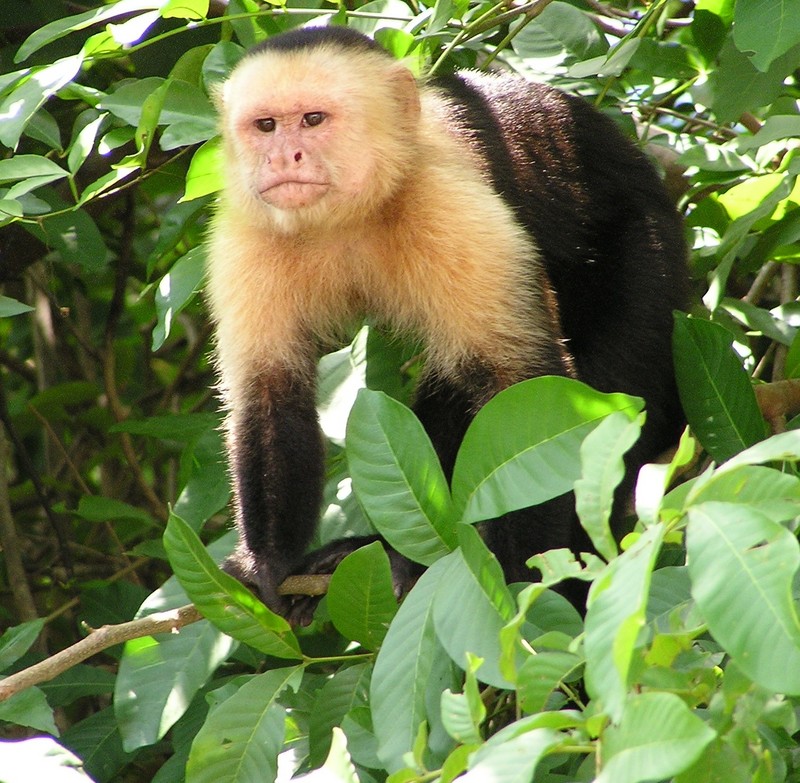|
| Query: white-faced capuchin | Result: 16th of 29 | |
White-headed Capuchin (Cebus capucinus) - Wiki
| Subject: | White-headed Capuchin (Cebus capucinus) - Wiki
| |

| Resolution: 1505x1473
File Size: 635342 Bytes
Date: 2005:07:13 20:28:33
Camera: C740UZ (OLYMPUS OPTICAL CO.,LTD)
F number: f/3.7
Exposure: 10/2000 sec
Focal Length: 630/10
Upload Date: 2006:12:17 15:02:07
|
ERROR : Server Busy(-1105)
ERROR : Server Busy(-1105)
White-headed Capuchin (Cebus capucinus) - Wiki
White-headed Capuchin
From Wikipedia, the free encyclopedia
[Photo] Wild Capuchin monkey (Cebus capucinus), on a tree near a river bank in the jungles of Guanacaste, Costa Rica. Taken by Storkk. Date Jul. 13, 2005. Author David M. Jensen (Storkk http://en.wikipedia.org/wiki/User:Storkk)
The White-headed Capuchin (Cebus capucinus), also known as the White-faced Capuchin or White-throated Capuchin, is a small New World monkey of the family Cebidae, subfamily Cebinae. Native to the forests of South and Central America, White-throated Capuchins are important to rainforest ecology by their role in dispersing seeds and pollen.
Among the best known monkeys, White-headed Capuchins are recognized as the typical companion to the organ grinder and for the role of "Marcel" in the popular television series Friends. They are highly intelligent monkeys and have been trained as assistants for paraplegic persons.
Physical description
Like other monkeys in the genus Cebus, White-headed Capuchins are named after the order of Capuchin friars: the cowls worn by these friars closely resemble the monkeys' head coloration. White-headed Capuchins have mostly black fur, with white to yellowish fur around the naked, pinkish face and on the shoulders; and, of course, white throats. A V-shaped area of black fur on the crown of the head is distinctive. The tip of the tail is often held coiled, giving White-headed Capuchins the nickname "ringtail".
Adults may reach a length of 435 millimetres and a weight of 3.9 kilograms. The tail is prehensile, dextrous, and longer than the body, at up to 551 millimetres in length. Males are perceptibly larger than females, becoming heavier in build with age. The brain of a White-throated Capuchin is circa 79 grams.
Behaviour and reproduction
Forming troops of up to 20 individuals, White-headed Capuchins are polygamous: the sex ratio is unbalanced, with females always outnumbering males. The troop is led by a dominant male and female; hierarchy is determined by lineage to this pair. They are diurnal and arboreal animals; highly active, most of their time is spent searching for food. White-throated Capuchins are characterised as being vociferous; loud calls are used to communicate threat warnings, with softer calls used in intimate discourse. Facial expressions and scent are also important to communication, with urine being a primary "perfume".
Claiming territories of between 320,000 to 860,000 square metres and covering up to 2 kilometres of these territories daily, White-headed Capuchins are highly inquisitive with proportionately large brains. Capuchins are considered among the smartest of the New World monkeys; they have been the subject of many behavioural and intelligence studies. The capuchins' intelligence is thought to be a result of their feeding habits; they rely on ephemeral food sources which may be hard to find. White-headed Capuchins are known to practice a sort of herbal medicine, rubbing plants into their fur; this may deter parasites such as ticks.
Elder males are the principal defenders of territory, with all members of the troop watching for threats (such as large birds, boas, and carnivorous mammals). Grooming pervades social interaction, with the amount of grooming received directly dependent on rank. Females associate closely among themselves, forming "coalitions" against potentially aggressive males.
Only one female is in estrous at one time; while no fights break out over her, it is usually only the dominant male who mates with her. The birthing season spans from December to April; gestation lasts for 157-167 days, usually resulting in a single birth. There is a minimum period of 19 months between births, although this period is much less if the infant dies.
The grey-faced infants stay close to their mothers, who habitually groom and carry their infants on their backs. Weaning occurs at 12 months with the infants gradually becoming more independent with age; they play among themselves, chasing and wrestling each other. Sexual maturity is reached at 2-3 years, with full adult size reached at 8 years. White-headed Capuchins typically live for 15-25 years or more in the wild, but may live for twice as long in captivity.
http://en.wikipedia.org/wiki/White-headed_Capuchin
| The text in this page is based on the copyrighted Wikipedia article shown in above URL. It is used under the GNU Free Documentation License. You may redistribute it, verbatim or modified, providing that you comply with the terms of the GFDL. |
|
Comments |
|---|
| | Guest |
|
| were does the White-headed Capuchin |
| | Guest |
|
| were does the White-headed Capuchin |

|

|

|
white-faced capuchin
16/29 |

|

|
^o^
Animal Pictures Archive for smart phones
^o^
|
|
|

